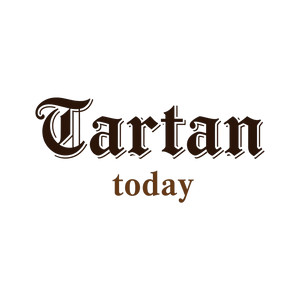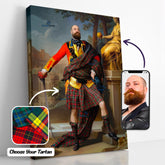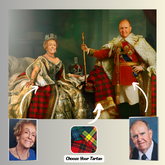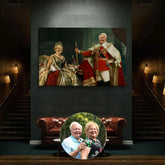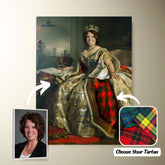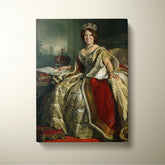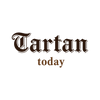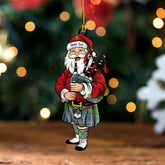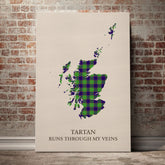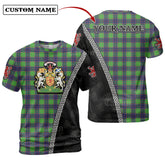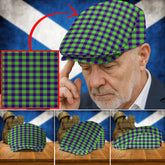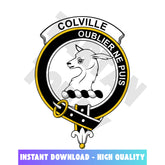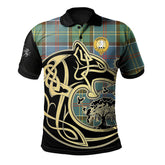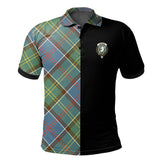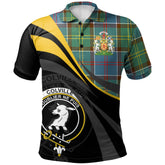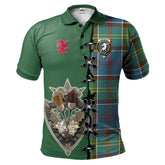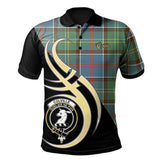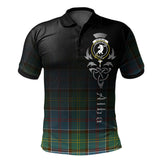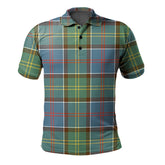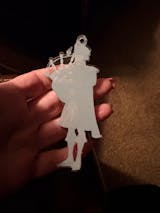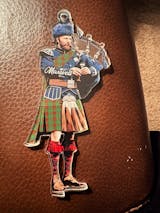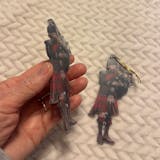-
Personalized Clan Colville Tartan Bagpipe Ornament with Custom Name – Scottish Christmas Tree Decoration IN64
Personalized Clan Colville Tartan Bagpipe Ornament with Custom Name – Scottish Christmas Tree Decoration IN64Celebrate your Scottish heritage with this unique wood & acrylic tartan ornament. Perfect as a personalized Christmas decoration or a meaningful gift for friends and relatives on special occasions such...- From $19.99 USD
$25.99 USD- From $19.99 USD
- Unit price
- per
Save $6.00 -
Personalized Clan Colville Tartan Drummer Ornament with Custom Name – Scottish Christmas Tree Decoration DW70
Personalized Clan Colville Tartan Drummer Ornament with Custom Name – Scottish Christmas Tree Decoration DW70Celebrate your Scottish heritage with this unique wood & acrylic tartan ornament. Perfect as a personalized Christmas decoration or a meaningful gift for friends and relatives on special occasions such...- From $19.99 USD
$25.99 USD- From $19.99 USD
- Unit price
- per
Save $6.00 -
Personalized Clan Colville Tartan Bagpipe Ornament with Custom Name – Scottish Christmas Tree Decoration PG62
Personalized Clan Colville Tartan Bagpipe Ornament with Custom Name – Scottish Christmas Tree Decoration PG62Celebrate your Scottish heritage with this unique wood & acrylic tartan ornament. Perfect as a personalized Christmas decoration or a meaningful gift for friends and relatives on special occasions such...- From $19.99 USD
$25.99 USD- From $19.99 USD
- Unit price
- per
Save $6.00 -
Personalized Clan Colville Reproduction Tartan Bagpipe Ornament with Custom Name – Scottish Christmas Tree Decoration NF12
Personalized Clan Colville Reproduction Tartan Bagpipe Ornament with Custom Name – Scottish Christmas Tree Decoration NF12Celebrate your Scottish heritage with this unique wood & acrylic tartan ornament. Perfect as a personalized Christmas decoration or a meaningful gift for friends and relatives on special occasions...- From $19.99 USD
$25.99 USD- From $19.99 USD
- Unit price
- per
Save $6.00 -
Personalized Clan Colville Modern Tartan Bagpipe Ornament with Custom Name – Scottish Christmas Tree Decoration RS12
Personalized Clan Colville Modern Tartan Bagpipe Ornament with Custom Name – Scottish Christmas Tree Decoration RS12Celebrate your Scottish heritage with this unique wood & acrylic tartan ornament. Perfect as a personalized Christmas decoration or a meaningful gift for friends and relatives on special occasions...- From $19.99 USD
$25.99 USD- From $19.99 USD
- Unit price
- per
Save $6.00 -
Personalized Clan Colville Ancient Tartan Bagpipe Ornament with Custom Name – Scottish Christmas Tree Decoration MM30
Personalized Clan Colville Ancient Tartan Bagpipe Ornament with Custom Name – Scottish Christmas Tree Decoration MM30Celebrate your Scottish heritage with this unique wood & acrylic tartan ornament. Perfect as a personalized Christmas decoration or a meaningful gift for friends and relatives on special occasions...- From $19.99 USD
$25.99 USD- From $19.99 USD
- Unit price
- per
Save $6.00 -
Personalized Clan Colville District Clan Crest Tartan Santa Ornament – Custom Acrylic Christmas Decoration FQ40 - Colville
Personalized Clan Colville District Clan Badge Tartan Ornament – Custom Acrylic Christmas Decoration FQ40Celebrate your Scottish heritage with this unique wood & acrylic tartan ornament. Perfect as a personalized Christmas decoration or a meaningful gift for friends and relatives on special occasions such as...- From $19.99 USD
- From $19.99 USD
- Unit price
- per
-
Colville
-
Custom Name Clan Colville Tartan Garden Flag with Clan Crest and the Golden Sword of Courageous Legacy BG68 - Colville
Custom Name Clan Colville Tartan Garden Flag with Clan Crest and the Golden Sword of Courageous Legacy BG68 Immerse your space in the rich heritage of Scotland with our Tartan Garden Flags, exclusively from Tartan Today. Featuring vibrant tartan and Scottish heritage designs, these garden...- From $34.45 USD
- From $34.45 USD
- Unit price
- per
-
Colville
-
Clan Colville Tartan Scotland Map Canvas “Tartan Runs Through My Veins” Wall Art NE34
Clan Colville Tartan Scotland Map Canvas “Tartan Runs Through My Veins” Wall Art NE34Celebrate your Scottish heritage with this striking canvas print featuring the map of Scotland filled with Colville tartan, paired with the bold phrase: “Tartan Runs Through My Veins.” Whether you're honoring...- From $35.05 USD
- From $35.05 USD
- Unit price
- per
-
Personalized Clan Colville Tartan Shirt with Scotland Coat of Arms & Custom Name ZK27 - Colville
Colville Tartan Shirt with Scotland Coat of Arms & Custom Name ZK27Celebrate your Scottish heritage with this Colville Tartan Shirt with Scotland Coat of Arms & Custom Name ZK27, featuring a bold Scotland Coat of Arms and your custom name on the back. Made...- From $39.54 USD
- From $39.54 USD
- Unit price
- per
-
Colville
-
Clan Colville Tartan Custom Face Hawaiian Shirt – Unisex Gift for Family Members, Summer Party QJ65 - Colville Tartan
Clan Colville Tartan Custom Face Hawaiian Shirt – Unisex Gift for Family Members, Summer Party QJ65?? Stand out with our custom face Hawaiian shirt featuring your chosen tartan pattern and up to 10 faces printed for free! Whether it's your own, your pet's, or...- $42.25 USD
$59.99 USD- $42.25 USD
- Unit price
- per
Save $17.74-
Colville Tartan
-
Clan Colville Tartan Flat Cap JE75 - Clan Colville Tartan
Clan Colville Tartan Flat Cap JE75Elevate Your Heritage: The Authentic Tartan Jeff Cap Step into a legacy of timeless style and comfort with our Authentic Tartan Flat Cap. Crafted for the discerning American who cherishes their Scottish roots and appreciates classic elegance, this isn’t just...- From $33.85 USD
$45.59 USD- From $33.85 USD
- Unit price
- per
Save $11.74-
Clan Colville Tartan
-
Clan Colville Tartan Crest, Badges, Heraldry, Clans, Family Scotland PNG, Digital ClipArt High Quality YG33
Clan Colville Tartan Crest, Badges, Heraldry, Clans, Family Scotland PNG, Digital ClipArt High Quality YG33 DIGITAL FILE ONLY* ** This listing is an INSTANT DIGITAL DOWNLOAD, not a physical item. An instant download is a digital file you can download and use immediately **...- $3.49 USD
$5.99 USD- $3.49 USD
- Unit price
- per
Save $2.50 -
Clan Colville Tartan Polo Shirt Viking Wolf ZX82 - Colville Tartan
Clan Colville Tartan Polo Shirt Viking Wolf ZX82 Description: Crafted in 100% polyester with your own design which combines comfort and vogue. This shirt has some'great features, it has 3 buttons, elastic collar and cuffs. 12.35 Oz. Made from polyester fabric. 3 buttons, elastic...- $38.25 USD
- $38.25 USD
- Unit price
- per
-
Colville Tartan
-
Clan Colville Tartan Polo Shirt Half of Me - Cross Style WJ65 - Colville Tartan
Clan Colville Tartan Polo Shirt Half of Me - Cross Style WJ65 Description: Crafted in 100% polyester with your own design which combines comfort and vogue. This shirt has some'great features, it has 3 buttons, elastic collar and cuffs. 12.35 Oz. Made from polyester...- $38.25 USD
- $38.25 USD
- Unit price
- per
-
Colville Tartan
-
Clan Colville Tartan Polo Shirt - Royal Coat Of Arms Style AS83 - Colville Tartan
Clan Colville Tartan Polo Shirt - Royal Coat Of Arms Style AS83 Description: Crafted in 100% polyester with your own design which combines comfort and vogue. This shirt has some'great features, it has 3 buttons, elastic collar and cuffs. 12.35 Oz. Made from polyester...- $38.25 USD
- $38.25 USD
- Unit price
- per
-
Colville Tartan
-
Clan Colville Tartan Polo Shirt - Lion Rampant And Celtic Thistle Style GX64 - Colville Tartan
Clan Colville Tartan Polo Shirt - Lion Rampant And Celtic Thistle Style GX64 Description: Crafted in 100% polyester with your own design which combines comfort and vogue. This shirt has some'great features, it has 3 buttons, elastic collar and cuffs. 12.35 Oz. Made from...- $38.25 USD
- $38.25 USD
- Unit price
- per
-
Colville Tartan
-
Clan Colville Tartan Polo Shirt - Believe In Me Style GX45 - Colville Tartan
Clan Colville Tartan Polo Shirt - Believe In Me Style GX45 Description: Crafted in 100% polyester with your own design which combines comfort and vogue. This shirt has some'great features, it has 3 buttons, elastic collar and cuffs. 12.35 Oz. Made from polyester fabric....- $38.25 USD
- $38.25 USD
- Unit price
- per
-
Colville Tartan
-
Clan Colville Tartan Polo Shirt - Alba Celtic Style NV79 - Colville Tartan
Clan Colville Tartan Polo Shirt - Alba Celtic Style NV79 Description: Crafted in 100% polyester with your own design which combines comfort and vogue. This shirt has some'great features, it has 3 buttons, elastic collar and cuffs. 12.35 Oz. Made from polyester fabric. 3...- $38.25 USD
- $38.25 USD
- Unit price
- per
-
Colville Tartan
-
Clan Colville Tartan Polo Shirt YK44 - Colville Tartan
Clan Colville Tartan Polo Shirt YK44 Description: Crafted in 100% polyester with your own design which combines comfort and vogue. This shirt has some'great features, it has 3 buttons, elastic collar and cuffs. 12.35 Oz. Made from polyester fabric. 3 buttons, elastic collar and...- $38.25 USD
- $38.25 USD
- Unit price
- per
-
Colville Tartan
Ex: Your Tartan + Product
Popular Products
Turn Me Royal Personalized Portrait from Your Photo, Custom Tartan. Custom Canvas Wall Art as Gift for Men
- From $32.45 USD
- From $32.45 USD
- Unit price
- / per
Royalty Couple Personalized Portrait from Your Photo, Custom Tartan. Custom Canvas Wall Art
- From $47.45 USD
- From $47.45 USD
- Unit price
- / per
The Queen Personalized Portrait from Your Photo, Custom Tartan. Custom Canvas Wall Art as Gift for Women
- From $32.45 USD
- From $32.45 USD
- Unit price
- / per
Which Clan Are You From?
List Of Tartan
-
Clan A
- Abercrombie Tartan
- Aberdeen Tartan
- Abernethy Tartan
- Adair Tartan
- Adam Tartan
- Ayrshire Tartan
- Agnew Tartan
- Aikenhead Tartan
- Ainslie Tartan
- Aiton Tartan
- Allan Tartan
- Alexander Tartan
- Allardice Tartan
- Allison Tartan
- Anderson Tartan
- Angus Tartan
- Anstruther Tartan
- Arbuthnot Tartan
- Armstrong Tartan
- Arnott Tartan
- Auchinleck Tartan
- Ayrshire Tartan
-
Clan B
- Baillie Tartan
- Bain Tartan
- Baird Tartan
- Balfour Tartan
- Bannatyne Tartan
- Bannerman Tartan
- Barclay Tartan
- Baxter Tartan
- Beaton Tartan
- Bell Tartan
- Belshes Tartan
- Bethune Tartan
- Beveridge Tartan
- Binning Tartan
- Bisset Tartan
- Blackadder Tartan
- Blackstock Tartan
- Black Watch Tartan
- Blair Tartan
- Blane Tartan
- Blyth Tartan
- Borthwick Tartan
- Boswell Tartan
- Bowie Tartan
- Boyd Tartan
- Boyle Tartan
- Brisbane Tartan
- Brodie Tartan
- Brown/ Broun Tartan
- Bruce Tartan
- Buccleuch Tartan
- Buchan Tartan
- Buchanan Tartan
- Burnett Tartan
- Burns Tartan
- Butter Tartan
- Byres Tartan
-
Clan C
- Cairns Tartan
- Calder Tartan
- Callander Tartan
- Cameron Tartan
- Campbell Tartan
- Campbell of Breadalbane Tartan
- Campbell of Cawdor Tartan
- Carmichael Tartan
- Carnegie Tartan
- Carruthers Tartan
- Cathcart Tartan
- Chalmers Tartan
- Charteris Tartan
- Chattan Tartan
- Cheyne Tartan
- Chisholm Tartan
- Christie Tartan
- Clark Tartan
- Clelland Tartan
- Clephan Tartan
- Clergy Tartan
- Cochrane Tartan
- Cockburn Tartan
- Colquhoun Tartan
- Colville Tartan
- Cooper Tartan
- Couper Tartan
- Craig Tartan
- Cranstoun Tartan
- Crawford Tartan
- Crichton Tartan
- Crief District Tartan
- Crosbie Tartan
- Cumming Tartan
- Cunningham Tartan
- Currie Tartan
- Clan D
- Clan E
- Clan F
- Clan G
- Clan H
- Clan I
- Clan J
- Clan K
- Clan L
-
Clan M
- Maitland Tartan
- Malcolm Tartan
- Mar Tartan
- Marjoribanks Tartan
- Maxtone Tartan
- Matheson Tartan
- Maule Tartan
- Maxwell Tartan
- Meldrum Tartan
- Melville Tartan
- Menzies Tartan
- Mercer Tartan
- Middleton Tartan
- Moffat Tartan
- Moncrieffe Tartan
- Montgomery Tartan
- Monypenny Tartan
- Moncreiffe Tartan
- Monteith Tartan
- Morrison Tartan
- Mouat Tartan
- Moubray Tartan
- Mow Tartan
- Muir_More Tartan
- Muirhead Tartan
- Munro Tartan
- Murray Tartan
- Murray of Atholl Tartan
-
Clan Mc/Mac
- MacAlister Tartan
- MacArthur Tartan
- MacAlpine Tartan
- MacAulay Tartan
- MacBain Tartan
- MacBean Tartan
- MacBeth Tartan
- MacCallum Tartan
- MacCraig Tartan
- MacColl Tartan
- MacCorquodale Tartan
- MacDiarmid Tartan
- MacDonald Tartan
- MacDonald of Clanranald Tartan
- MacDonald of Sleat Tartan
- MacDonnell of Glengarry Tartan
- MacDonnell of Keppoch Tartan
- MacDougall Tartan
- MacDowall Tartan
- MacDuff Tartan
- MacEwen_MacEwan Tartan
- MacEdward Tartan
- MacFarlane Tartan
- MacGill Tartan
- MacGillivray Tartan
- MacGregor Tartan
- MacGowan (McGowan) Tartan
- MacHardy Tartan
- MacIan Tartan
- MacInnes Tartan
- MacIntyre Tartan
- MacKay Tartan
- MacKillop Tartan
- MacKellar Tartan
- Mackinlay Tartan
- MacKenzie Tartan
- Mackie Tartan
- MacKinnon Tartan
- MacKintosh / MacIntosh Tartan
- MacLeod Tartan
- MacMillan Tartan
- MacNab Tartan
- MacNaughton Tartan
- MacNeil / MacNeill Tartan
- MacNeil of Colonsay Tartan
- MacNicol Tartan
- MacPhail Tartan
- MacPhee_MacFie Tartan
- MacPherson Tartan
- MacQuarrie Tartan
- MacQueen Tartan
- MacRae Tartan
- MacRow Tartan
- MacSporran Tartan
- MacTaggart Tartan
- MacTavish Tartan
- MacThomas Tartan
- McCorquodale Tartan
- McCulloch Tartan
- McFadzen Tartan
- McGeachie Tartan
- McIver Tartan
- McKerrell Tartan
- Clan N
- Clan O
- Clan P
- Clan R
-
Clan S
- Sandilands Tartan
- Scott Tartan
- Scrymgeour Tartan
- Selkirk Tartan
- Sempill Tartan
- Seton Tartan
- Shaw Tartan
- Shepherd Tartan
- Sinclair Tartan
- Skene Tartan
- Skirving Tartan
- Smith Tartan
- Somerville Tartan
- Spalding Tartan
- Spens Tartan
- Spottiswood Tartan
- Stevenson Tartan
- Stewart Tartan
- Stewart of Appin Tartan
- Stirling Tartan
- Strachan Tartan
- Straiton Tartan
- Strange Tartan
- Strathclyde District Tartan
- Stuart of Bute Tartan
- Sutherland Tartan
- Swinton Tartan
- Clan T
- Clan U W Y
- Request Your Clan
Clan Colville (Colville Tartan)
1. About Clan Colville (Colville Tartan)
Crest: A hind’s head couped at the neck, Argent
Motto: Oblier Ne Puis (I cannot forget)
Origin of Name: Placename, Normandy
Lands: Roxburghshire and Ayrshire
Clan Chief: The Rt. Hon. The Viscount of Culross
2. Colville Clan History (Colville Tartan)
The origin of this name is Colville-Sur-Mer in Normandy. They most likely came across during the Norman Conquests with William the Conqueror. In Scotland, the Colville family first appears in the 12th century.
A charter from Malcolm IV to the Monastery of Dunfermline identified Philip de Colville as a witness (Dunfermline Abbey main image). He was taken hostage at a later date (a very typical procedure in middle ages Europe), and his liberation was eventually swapped for William the Lion's release in 1174.
Along with other lands in Ayrshire, the Colvilles received baronies in Roxburghshire. William, the son of Phillips, eventually acquired the Stirlingshire barony of Kinnaird.
Sir Reginald Cheyne of Inverugie passed away in 1291. E'stace, an heiress of Sir William Colville of Oxnam, became his widow.
She signed the Ragman Roll, along with other people. Despite this, she is credited with improving the Colvilles' finances.
Grants she donated to the Abbey of Melrose were later validated in 1324. The barony of Ochiltree was confirmed by David II in 1350.
After John Auchinleck, a companion of the Earl of Douglas, was murdered, the Colvilles and the Douglasses grew apart from one another.
The ensuing feud robbed the Colville family a lot of their holdings and cost them control of the Kinnaird fortress, which was captured by force.
At Stirling Castle, the King killed the Earl by stabbing him. In 1450, the Colville family relocated to a new house far from the Auchinlecks.
Sir Robert Colville served as James the 4th's household master and steward to Queen Margaret. In order to fight for the King, he gathered an army from his estate. Together with Sir Robert in 1513, the majority of his force perished at Flodden.
Sir James Colville of Ochiltree, the son of Sir Robert, was chosen to serve in the Royal Household in 1527. He traded his estate at Ochiltree for the baronies of East Wemyss and Lochorshyre in Fife with Hamilton of Finnart three years later, in 1530.
Unfortunately, he was afterwards accused of treason, and the properties were held by the Crown until 1543.
For King Henry IV, Sir James Colville of Easter Wemyss fought in France. The chiefs still refer to him as "Lord Colville of Culross," a title he received in 1604.
When the second Lord of Colville passed away without an heir in 1640, the title of Lord Colville was lost. When John Colville was elevated to the peerage "de jure" in 1723, the title was finally restored.
Honorable Charles Colville, who was in charge of the 21st Regiment of Foot, took part in the Battle of Culloden in 1746. The Honourable Alexander Colville joined the navy in 1731 but chose a career in the navy.
In 1755, he was made commodore and sailed the Northumberland to America. He participated in the liberation of Quebec, which the French had besieged. After that, he was promoted to Vice Admiral.
After participating in the Peninsular War and the Battle of Waterloo in 1815, Sir Charles Colville was awarded the Knight Grand Cross of the Order of the Bath.
After his passing, his son Charles was elevated to the peerage, and he was later made Viscount Colville of Culross.
Sir Andrew Colville, who discovered a tribe in that area, is honored by having his name given to the town of Colville in northern Washington, United States.
This family has a number of titles, one of which is Viscount Colville of Culross. In 1945, the current Viscount—the twelfth Lord Colville of Culross—took the throne.
3. Colville Clan Tartans
There isn't a Colville clan tartan that is recognized. However, those with the surname are permitted to don the Ayrshire District tartan, which honors the region where the name was formerly established.
For those Ayrshire families without clan ties, the Clan Boyd and Clan Cunningham Societies commissioned the creation of the Ayrshire tartan. The colors stand for:
The sun's rising gold
The land is green.
of the seashore in brown
a sea of blue
the sun's fading sun's red
Threadcount Y4 G32 DT16 B40 R4 B/8 Threadcount G/8
Ayrshire District
4. Clan Colville Crest & Coats of Arms
4.1 Clan Colville Crest
Worn by all of the name and ancestry
4.2 Clan Colville Coat of Arms
Arms of Colville, Lord and Viscount Colville, and Lord Colvill of Ochiltree:
First and fourth of each quarter: Argent, a cross moline sable (for Colville). Gules, a fess chequy argent and azure (2nd and 3rd) (for Lindsay)
Coleville of Cullross
Quarterly (divided), 1st & 4th Gules, a fess chequy, Argent (silver or white), and Azure (blue); 2nd & 3rd Argent (silver or white), a cross moline, Sable (black).
Arms of Colville covering a 1705 book
5. Clan Colville Places & People
5.1 Clan Colville People
5.1.1 Sir Charles Colville (1770 – 1843)
British military commander who attained the rank of Lieutenant General and participated in the Battle of Waterloo in the Peninsular War. Knight Grand Cross of the Order of the Bath and Knight Grand Cross of the Royal Guelphic Order were awarded to him.
5.1.2 John Colville (c. 1540-1605)
He was the son of Robert Colville of Cleish in Kinross, a Scottish minister, judge, politician, and writer.
He received his education at the University of St. Andrews and was ordained as a Presbyterian pastor, but his main interest was political espionage.
He provided the English government with confidential intelligence about Scottish affairs. In 1582, he participated in the Raid of Ruthven by joining the forces of the Earl of Gowrie.
He served as the Commissioner for Stirling in the Scottish Parliament in 1587 and briefly had a seat on the bench of the judiciary.
He was declared illegal along with the Earl of Bothwell in December 1591 after being connected to the raid on Holyrood Palace.
He is reported to have retired overseas and joined the Roman Church. 1605 saw his passing in Paris.
A number of writings, including an Oratio Funebris on Elizabeth I of England and some contentious essays on politics and religion, were written by Colville.
According to legend, he was also the author of The Historie and Life of King James the Sext, which T. Thompson edited for the Bannatyne Club in Edinburgh in 1825.
The editor, David Laing, provided a biographical memoir in Colville's Original Letters, 1582-1603, which was released by the Bannatyne Club in 1858.
6. Associated Names
COLVIN
7. Clan Colville: Tracing the Ancient Norman Origins
The fascinating history and legacy of the Clan Colville chiefs
In this in-depth article, we explore the rich and ancient Norman origins of the Clan Colville chiefs. With a storied history that dates back centuries, the Clan Colville has left an indelible mark on Scottish history.
From their first appearance in Scotland to their noble titles and military achievements, the Colville clan has contributed significantly to the fabric of Scottish society. Join us as we delve into the origins, lineage, and notable members of the Clan Colville.
7.1 The Arrival of Philip de Colville
Philip de Colville, believed to be of Norman descent, arrived in Scotland before 1159. He played a significant role in Scottish history and was a witness to a charter to Dunfermline Monastery.
Additionally, Philip was one of the hostages used for the release of William the Lion in 1174, highlighting his close ties to the Scottish monarchy.
7.2 Acquisition of Baronies and Lands
As a testament to their influence and favor with the Scottish crown, the Colville family received grants of various baronies and lands.
Philip de Colville was granted the baronies of Oxnam and Hecton in Roxburghshire, as well as lands in Ayrshire. These acquisitions solidified their position as prominent landowners and further elevated their status within Scottish society.
8. The Lineage of Clan Colville
From generation to generation, the Clan Colville chiefs have passed down their titles, wealth, and influence. The lineage of Clan Colville showcases notable figures who contributed significantly to Scottish history.
8.1 Thomas de Colville: The Wrongly Accused
Thomas de Colville, the son of Philip, continued the family legacy. He witnessed several charters of William the Lion between 1189 and 1199, showing the family's continued involvement in the affairs of the Scottish monarchy.
However, tragedy struck when Thomas was wrongly suspected of treason and imprisoned in Edinburgh Castle. Despite this injustice, he later regained royal favor and passed away on his own estates in 1219, leaving behind a legacy of resilience and loyalty.
8.2 William de Colville and the Seat at Kinnaird
The next prominent figure in the Clan Colville lineage was William de Colville, the son of Thomas de Colville. William acquired the barony of Kinnaird in Stirlingshire, which remains the chief's seat to this day. His ownership of Kinnaird solidified the Colville clan's connection to the land and provided a lasting symbol of their influence.
8.3 E'stace: The Heiress of Sir William Colville
E'stace, the heiress of Sir William Colville, married Sir Reginald Cheyne. Her appearance on the Ragman Rolls of 1296, where she swore fealty to Edward I of England, showcases the complex political landscape of the time.
E'stace's abilities and acumen are often attributed to the founding of the Colville fortunes.
8.4 Robert Colville: Baron of Ochiltree
Robert Colville, described as the Baron of Ochiltree, made significant contributions to religious institutions.
He confirmed a grant made to Melrose Abbey and made donations to the monks of Kelso Abbey. In addition, David II of Scotland confirmed his barony of Ochiltree in 1350, solidifying his status as a prominent figure.
9. Notable Figures and Events in Clan Colville's History
The history of Clan Colville is punctuated by notable figures and events that shaped the clan's legacy. From military achievements to political appointments, the Colville chiefs distinguished themselves in various fields.
9.1 Thomas Colville and the Marriage of Princess Margaret
Thomas Colville of Oxnam, likely the grandson of Robert Colville, accompanied Princess Margaret, daughter of James I of Scotland, to France for her marriage to the Dauphin of France in 1436. This event highlights the Colville clan's close ties to the Scottish monarchy and their involvement in diplomatic affairs.
9.2 Sir James Colville: Comptroller of the Royal Household
Sir James Colville, the son of Robert Colville of Hilton, was appointed to the office of Comptroller of the Royal Household in 1527. This prestigious position showcased the Colville clan's prominence within the royal court, solidifying their status as trusted advisors to the monarchy.
9.3 Sir James Colville: Lord Colville of Culross
In 1604, Sir James Colville was raised in the peerage with the title 'Lord Colville of Culross,' a title still held by the chiefs today. This elevation to the peerage emphasized the Colville clan's noble lineage and marked them as distinguished members of Scottish society.
9.4 Charles Colville: Supporter of the British Government
During the Jacobite rising of 1745, Charles Colville supported the British Government and commanded the 21st Regiment of Foot (Royal Scots Fusiliers) at the Battle of Culloden. His commitment to the British cause elevated his rank to lieutenant general and showcased the Colville clan's unwavering loyalty.
9.5 Alexander Colville: Naval Commander and Vice Admiral
Alexander Colville, 7th Lord Colville of Culross, distinguished himself as a naval commander. He became a captain of HMS Leopard in 1744 and later obtained command of HMS Northumberland, where he forced the French to raise the siege of Quebec in 1759. His promotions to commodore and vice admiral reaffirm the Colville clan's military prowess.
9.6 Stanley Colville: Rear Admiral and Commander in Chief
Sir Stanley Colville, brother of the second Viscount, served as rear admiral and commander in chief at Portsmouth from 1916 to 1919. His contributions during World War I marked a more contemporary chapter in the Colville clan's military engagements.
10. The Modern Clan Colville
The modern Clan Colville is represented by Charles Colville, the 14th Lord Colville of Culross, who is currently the Clan Chief and a member of the House of Lords.
This continuation of the noble lineage ensures the preservation of the Colville clan's ancient heritage and its continued presence in contemporary Scottish society.
10.1 Mark Colville: A Legacy in Politics and Human Rights
Mark Colville, the 13th Lord Colville of Culross, gained the title in 1945 and left a lasting impact on British politics. He served as a Home Office Minister under Edward Heath and was also a member of the UN Human Rights Commission.
His contributions to politics and human rights elevated the Colville clan's influence beyond Scotland's borders.
10.2 Charles Colville: Continuing the Legacy
Charles Colville, the current Clan Chief, carries the responsibility of upholding the traditions and values of the Clan Colville.
As a member of the House of Lords, he plays an active role in British governance, further solidifying the clan's role in contemporary society.
11. Conclusion
The Clan Colville chiefs have a deep-rooted and ancient Norman origin, with a lineage that can be traced back centuries. From their first appearance in Scotland to their noble titles and military achievements, the Clan Colville has left an indelible mark on Scottish history.
Through their resilience, loyalty, and contributions to various fields, the Colville clan has cemented its place as an integral part of Scottish society.
With Charles Colville at the helm, the Clan Colville proudly continues its legacy, ensuring that its history will endure for generations to come.
- Choosing a selection results in a full page refresh.
